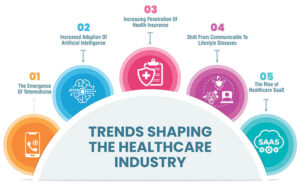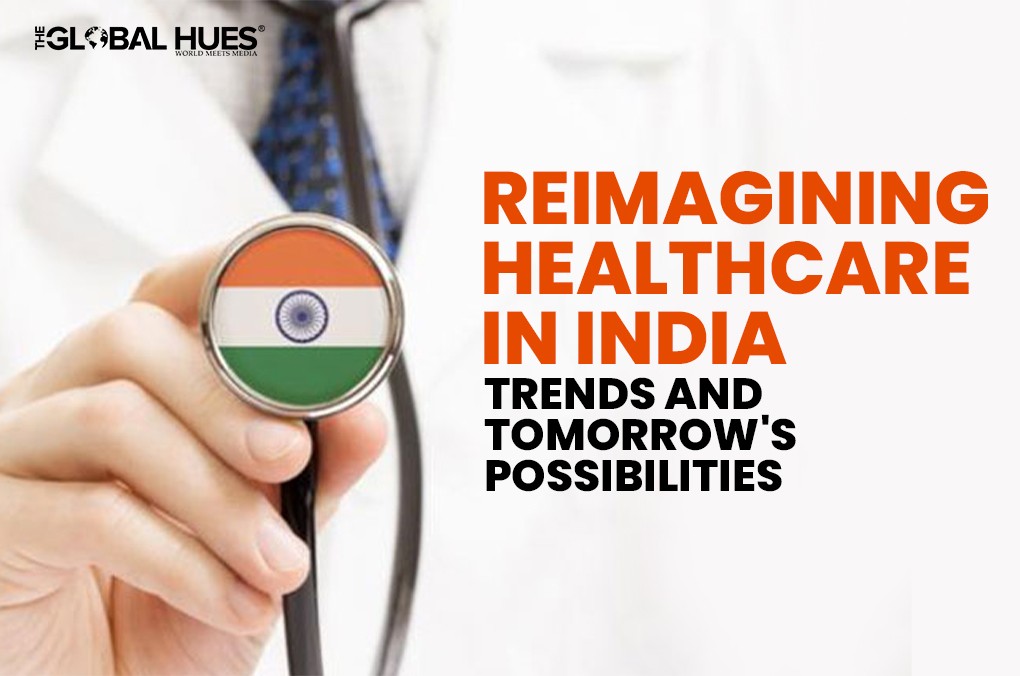In the Union Budget 2023-24, the Health sector has been allocated Rs 89,155 crore, a hike of around 13 per cent over the budget allocated in 2022-23. Healthcare has become one of India’s prominent sectors, both in terms of employment and revenue. Healthcare in India is growing tremendously due to greater health awareness, rising income, lifestyle diseases, increased emphasis on public-private partnerships and increasing access to insurance.
Imagine patients talking to doctors through video calls on their phones, robots carrying out medical procedures, and a government application helping the vaccination of more than 2 billion people during a global pandemic. All this seemed like something out of a science fiction story, especially in India. But guess what? Today these incredible things are taking place right in front of our eyes. Crazy how times have changed. The healthcare sector has undergone a remarkable transformation. It’s like we’re living in a whole new world compared to what things were like just a couple of decades ago.
MARKET SIZE OF HEALTHCARE SECTOR IN INDIA
| Year | Growth (US$ Billion) |
| 2016 | 110 |
| 2017 | 160 |
| 2020 | 280 |
| 2022 | 372 |
| 2025* | 638 |
Source: India Brand Equity Foundation (IBEF)
The Indian Healthcare sector is one of the leading contributors to the Indian economy. Despite digitisation playing a crucial role in the growth of healthcare, the Covid-19 pandemic has catalysed long-term behavioural transformation towards personal health and hygiene, fitness, health insurance and medical check-ups.
India’s healthcare sector comprises medical devices, health insurance, telemedicine, clinical trials and medical tourism. These market segments are predicted to expand and evolve, especially when more people lean towards proactive and preventive healthcare measures.
INVESTING IN THE FUTURE OF HEALTHCARE
The healthcare industry is growing, health tech startup ecosystem has witnessed a surge in funding. But why are investors and venture capitalists investing in them?
- India is the most populated country in the world with 1.4 billion people. Due to increasing awareness about hygiene and health, more and more people are accessing healthcare.
- The government of India is also aggressively spending on healthcare. It has launched Rashtriya Swasthya Bima Yojana, Pradhan Mantri Jan Arogya Yojana and many other schemes and initiatives to increase access to quality and affordable healthcare.
- India is a nation of qualified engineers and creative scientists who are tirelessly working on innovative health technology solutions.
All these factors attract investors and VCs to invest in the healthcare infrastructure. Here are the top 10 most funded healthcare startups in India.
Top 10 Most Funded Healthcare Startups in India
| Startups | Total Funding in USD | Location |
| API Holdings | 1.13 Billion | Mumbai (India) |
| Pharmeasy | 1.10 Billion | Mumbai (India) |
| Cult.fit | 655 Million | Bengaluru (India) |
| Innovaccer | 379 Million | Bengaluru (India) |
| Tata Digital Health | 303 Million | Bengaluru (India) |
| Ascent Health & Wellness Solutions | 295 Million | Mumbai (India) |
| Practo | 251 Million | Bengaluru (India) |
| Healthkart | 224 Million | Gurgaon (India) |
| Indegene | 220 Million | Princeton (US) & Mumbai (India) |
| Pristyn Care | 181 Million | Gurgaon (India) |
Source: Tracxn as of July 2023
FACTS ABOUT THE INDIAN HEALTHCARE SECTOR
- As of 2021, the Indian healthcare sector stands as one of the nation’s largest employers. The sector employs approximately 4.7 million people. Between 2017-22, it generated 2.7 million additional jobs in India; equating to over 500,000 new jobs per year.
- The pharmaceutical sector plays a crucial role in the success of India’s healthcare industry. With a turnover of $42 billion, India is commonly referred to as the “pharmacy of the world” due to being the largest producer and exporter of generic medicines.
- As of November 24, 2022, more than 219.88 crore COVID-19 vaccines have been administered across India.
- As per the Economic Survey 2022-23, India’s public expenditure on healthcare reached 2.1 % of GDP in FY23 and 2.2% in FY22, against 1.6% in FY21.
TRENDS SHAPING THE HEALTHCARE INDUSTRY

-
The Emergence Of Telemedicine
The telemedicine market in India was valued at $1.10 Bn in 2022 and is estimated to expand at a CAGR of 21.2% from 2022-30. It will reach $5.15 Bn by 2030. The Covid-19 pandemic has changed people’s habits. The way healthcare used to operate, with doctors and patients physically meeting, has undergone a significant transformation. Thanks to the Government of India’s decision in 2020 to establish telemedicine guidelines which have paved the way for a structured approach, enabling doctors to offer online consultations to their patients.
Telemedicine typically involves using audio, text, or video to diagnose and treat patients. With the help of smartphones, tablets, laptops, or PCs, state-of-the-art technologies allow people to ask questions and do live consultations with doctors. Technological advancements and the integration of chatbots and robots into online platforms and smartphone apps to gather personal and health details are driving growth factors.
Moreover, the increasing prevalence of different cardiovascular diseases (CVDs) is also leading to the increase in demand for effective home monitoring systems, smartwatches, smartphone apps, and wearable devices to check blood pressure, sleeping patterns and other health parameters.
-
Increased Adoption Of Artificial Intelligence
Artificial intelligence is contributing a lot to the development of the healthcare industry. It is helping medical professionals make more informed decisions based on accurate information. From identifying novel cancer treatments to enhancing patient experiences, AI promises to be a game changer in the healthcare domain. As AI possesses the ability to process big data sets, it can help consolidate patient insights leading to predictive benefits, thus helping the healthcare ecosystem discover key areas of enhanced patient care.
Additionally, AI can automate administrative tasks like maintaining records, pre-authorizing insurance, and following up on unpaid bills, hence easing the workload of professionals and ultimately saving time and money. It further allows them to invest time in other significant healthcare activities.
It takes millions of dollars and thousands of human hours to put a drug through clinical trials but thanks to AI, biopharmaceutical companies are leveraging the technology to develop medicines and bring them to the market.
-
Increasing Penetration Of Health Insurance
According to Mordor Intelligence, The India Health And Medical Insurance Market size is estimated at INR 0.82 trillion in 2023. It is expected to grow substantially and reach INR 1.36 trillion by 2028, growing at a CAGR of 10.60% during 2023-2028. The Covid-19 pandemic impacted the entire health insurance segment in India. With higher risks of hospitalisation and exorbitant medical costs in private hospitals, more Indians have recognized the importance of having health insurance. Having health insurance leads to improved access to healthcare services.
Many international companies like Allianz SE (Germany), Insurance Australia Group – AIG (Australia), Tokio Marine (Japan), BUPA Finance PLC (UK), Munich Health (Germany), and more have formed partnerships with Indian counterparts to establish their presence in the growing Indian insurance market.
-
Shift From Communicable To Lifestyle Diseases
With people adopting unhealthy diets and consuming alcohol and tobacco, many lifestyle diseases like obesity, diabetes, cancer, chronic lung disease and cardiovascular disease (CVD) are increasing. Due to the rise in urban living and the challenges that come with it, roughly half of the expenses for in-patient beds are now allocated to treating lifestyle diseases. This shift has led to a greater need for specialised medical attention. In India, lifestyle diseases have taken over as the main health concerns, replacing the traditional ones.
Lifestyle Diseases among Indians in 2021
| Diseases | Teens (less than 19 years old) | Young Adults (20-29 years old) | Adults (30-44 years old) | Older Adults (45-59 years old) | Seniors (60 years and above) |
| Diabetes | 6.7% | 3.3% | 9.3% | 25% | 43.4% |
| Cholesterol | 7.4% | 5.7% | 13.9% | 23.5% | 29.5% |
| Blood Pressure | 7.4% | 5.6% | 13.6% | 35.1% | 57% |
| Thyroid | 5.1% | 0.5% | 7.2% | 9.6% | 12.7% |
Source: Statista
-
The Rise of Healthcare SaaS
According to a report by Grand View Research, the healthcare SaaS industry would experience a remarkable growth rate with a CAGR of 19.5% and reach $50 billion by 2028. The market for healthcare SaaS is exploding and is becoming increasingly popular due to its ability to improve patients’ experiences.
Healthcare software as a service (SaaS) has gained significant traction as a sought-after solution for healthcare companies aiming to enhance their efficiency and the standard of patient care. In the era of digitalisation, healthcare providers require effective ways to store electronic health records and data for managing the health of the entire population. SaaS-based solutions assist healthcare providers in efficiently managing essential aspects like patient medical records, appointment scheduling, billing information, patients’ information, and more.
Benefits of SaaS in Healthcare:
- Cost-effectiveness: SaaS enables the healthcare industry to save on operational, configuration, maintenance and unwanted expenses.
- Swift Backups: SaaS applications ensure data backup and recovery of data & records in times of emergency.
- Flexibility: With the help of SaaS, applications can be configured for different populations and geographies, allowing the healthcare industry to provide quality care to patients based on their needs.
- Accessibility: The applications allow authorised users to access information and data from any geographical location at any time, allowing doctors to communicate with patients, irrespective of where they are.
- Realtime Updates: SaaS provides real-time modifications, ensuring healthcare and medical firms that their data is always up-to-date.
What Does the Future Behold?
From the emergence of telemedicine services to the increased adoption of artificial intelligence and digital technologies, the emerging trends highlight the tremendous growth potential of the Indian healthcare sector. India is gearing up to provide affordable quality healthcare through several innovative initiatives. The nation looks forward to better health outcomes and the development of the healthcare industry.




